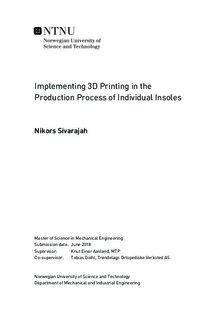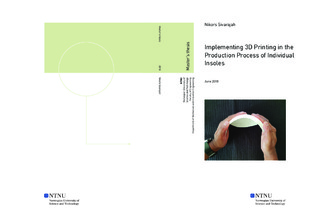| dc.description.abstract | The short dated and specific objective of this project is to find solutions for insoles based on 3D printing. This includes the application of 3D-printing for final products. Off-the-shelf insoles, also called generic insoles, are often manufactured in large batches. Therefore, it is most relevant and interesting to focus on 3D-printing on highly complex and advanced insoles, also known as individual insoles.
The overall problem to be addressed:
Can 3D printing be used in an effective way to make individual insoles or parts of it with satisfactory properties?
The problem was approached by first observing the current process at TOV, an orthopedic workshop in Trondheim. It was found that the insoles can be classified into three categories which are off-the-shelf, milled and vacuum produced. Vacuum production is the process which is most time consuming one. It is therefore the main area of focus since it has the greatest potential concerning 3D-printing. 3D scanning applications were tested and a 3D printer was built to get a clear understanding of the true objective. A thorough research on existing solutions was conducted to learn from other company s experiences. Technicians and orthotists were also interviewed to obtain knowledge about how an insole should behave. This increased focus on material types and the requirements to find a suitable material for an individual insole.
Different product development methodologies such as Design Thinking and IPM-model was used in the development process to solve several issues concerning the production of 3D-printed insoles. Scrum was used as a framework to push the project in the right direction. CAD software was used to design a model of the insole to make it 3D-printable, and different flexible filaments were tested to find a suitable material for printing the insoles. Compressive tests and hardness tests of the polymer-material, which is used for making the current insoles, were performed to acquire relevant material properties. This would help designing a resembling structure with comparable properties of the current insoles. The solution was a general method which could be used and adapted into the diverse types of currently existing 3D-printers. Finding an expression for a material property depending on 3D printing parameters could help obtaining new values for the material properties when the aforementioned parameters changes.
This thesis was written to fulfill the final requirement from a 5 year master`s degree programme in Mechanical Engineering at NTNU in Trondheim and was carried out in close collaboration with Trøndelags Ortopediske Verksted AS (The Orthopaedic Workshop of Trøndelag) in Norway. | |

